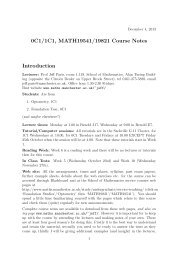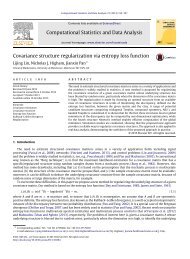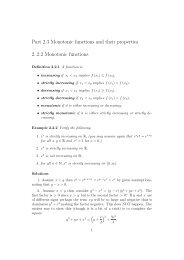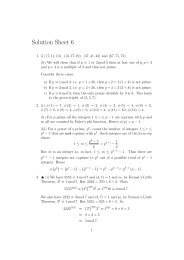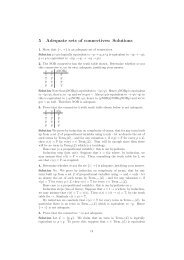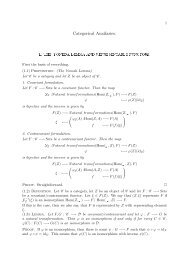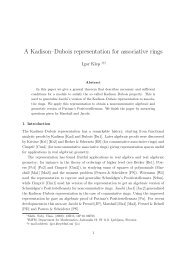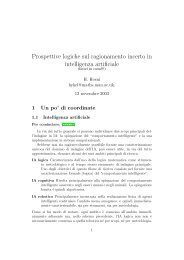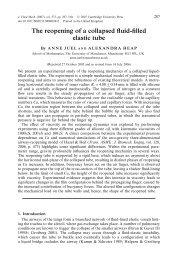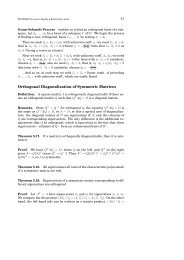Aktharuzzaman, Tanvir Noor Baig and K Siddique-e Rabbani ...
Aktharuzzaman, Tanvir Noor Baig and K Siddique-e Rabbani ...
Aktharuzzaman, Tanvir Noor Baig and K Siddique-e Rabbani ...
You also want an ePaper? Increase the reach of your titles
YUMPU automatically turns print PDFs into web optimized ePapers that Google loves.
Microcontroller based FIM system<br />
Design of a Microcontroller Based 4-Electrode Focused<br />
Impedance Measurement (FIM) System<br />
<strong>Aktharuzzaman</strong> 1 , T N <strong>Baig</strong> 1 <strong>and</strong> K S <strong>Rabbani</strong> 2<br />
1 Biomedical Physics Laboratory, Department of Physics, University of Dhaka<br />
2 Department of Biomedical Physics & Technology, University of Dhaka<br />
Abstract: Hardware <strong>and</strong> software design was performed to implement the newly developed 4<br />
electrode Focused Impedance Method (FIM) based on a microcontroller which involved<br />
complex switching of current sources <strong>and</strong> amplifier inputs to the 4 electrodes, data acquisition,<br />
analysis <strong>and</strong> display of output. The developed design <strong>and</strong> software were evaluated using a<br />
circuit simulator software <strong>and</strong> the system performed the desired functions very well.<br />
Keywords: Focused Impedance, Electrical Impedance, Instrumentation<br />
1. Introduction<br />
Focused Impedance Method (FIM) is a new modality of bio-electric impedance measurement<br />
developed at the Biomedical Physics Laboratory of the University of Dhaka of which two versions<br />
appear to have potential in physiological study <strong>and</strong> diagnosis, one with 6 electrodes (<strong>Rabbani</strong> et al<br />
1998, 1999) <strong>and</strong> one with 4 electrodes (<strong>Rabbani</strong> <strong>and</strong> Karal, 2007). In the four electrode version the<br />
electrodes are placed at the corners of a square matrix where each of the adjacent electrode pairs acts<br />
as a current drive <strong>and</strong> potential is measured across the opposite pair. Four arrangements are possible<br />
by rotating the configuration in steps of 90 0 . The four measured potentials, which are proportional to<br />
the respective impedances (because of a constant driving current), are summed to give the focused<br />
impedance value. This however needs a complex switching of electrodes which has to be done<br />
automatically for any practically usable equipment <strong>and</strong> a microcontroller (μC) based measurement<br />
system is attractive from a practical st<strong>and</strong>point. This paper presents such a μC based 4-electrode FIM<br />
system being developed at our laboratory.<br />
2. Instrumentation of 4-electrode FIM system<br />
A block diagram of the designed system is shown in figure 1. Here, two analog switch ICs, under<br />
program control, are used to switch both the current drive <strong>and</strong> potential measuring circuitry to the<br />
appropriate electrodes attached to the ‘body’. The measured potential is an ac signal which is<br />
amplified, filtered, converted to an equivalent dc, <strong>and</strong> given necessary dc level shift to make the data<br />
suitable for the next stage. All this is done by the potential measuring circuitry shown <strong>and</strong> the output<br />
Constant current<br />
generator (ac)<br />
Switching<br />
device<br />
Body<br />
Switching<br />
device<br />
Potential<br />
measuring<br />
unit<br />
Latch<br />
7-seg display<br />
Figure 1: Block diagram for a microcontroller based 4 electrode FIM system<br />
PIC16F877A Microcontroller with<br />
AD converter<br />
is acquired by the μC through its ADC input which converts the signal to the corresponding binary<br />
digital value. For the four measurement sets needed for focusing, the appropriate switching is
Microcontroller based FIM system<br />
performed by the μC <strong>and</strong> the corresponding output digital values are stored in its memory. At the end<br />
of the sequence, the four stored values are summed <strong>and</strong> the result is displayed through a 7-segment<br />
Display.<br />
3. Circuit design, programming <strong>and</strong> simulation<br />
Considering the availability, cost <strong>and</strong> performance a microcontroller (μC), PIC16F877A, with a built<br />
in Analogue to Digital Converter (A/D Converter) was chosen to design the system. After preliminary<br />
design, circuit simulation was performed using a software package named ‘Proteus 7’. The<br />
programming of the μC was done in its ‘Assembly’ language. The different stages of the designed<br />
system are discussed briefly in the following subsections.<br />
Switching: SPDT analog switch IC ADG333A was used for the complex switching<br />
operations under program control. A truth table for the switching sequence was developed<br />
<strong>and</strong> optimised for this purpose, <strong>and</strong> the μC program was written based on this truth table.<br />
Data acquisition: As mentioned earlier, the built-in A/D converter of PIC16F877A was used<br />
for this purpose for which a program sub-routine was developed. It gave the right output<br />
signals to perform the desired switching operations, to acquire the four output values in<br />
sequence, <strong>and</strong> to store them in specified locations in memory.<br />
Summing up the acquire data: Another programming sub-routine was developed to add all<br />
the four acquired output values, in binary form. His routine also converted the binary data<br />
into corresponding hexadecimal values <strong>and</strong> stored in another memory location.<br />
Display operation: Four 7-segment displays with built-in hexadecimal to 7-segment display<br />
converter were used for displaying the resultant output, in hexadecimal numbers. Due to non<br />
availability of the right components the display was done in hexadecimal, however, the final<br />
design would be done to display the result in decimal numbers. The internal output of the μC<br />
had 16 bits, while the I/O port of PIC16F877A had only 8 pins. So the data transfer was done<br />
in two steps using two octal latches, through multiplexing. Another programming sub-routine<br />
was developed for this operation.<br />
Simulation: The performance of each individual sub-routines <strong>and</strong> that of the total program<br />
were examined together with the switching schemes using the simulation software as<br />
mentioned before. Simulated analogue input values were put in <strong>and</strong> the displayed numerical<br />
outputs were noted. All the results conformed exactly to the functions desired.<br />
4. Conclusion<br />
The design of the 4 electrode FIM circuitry together with the necessary program for the<br />
microcontroller was a success, as verified through the simulation experiment using Proteus 7<br />
software. The next step would be the implementation of the hardware for the 4 electrode FIM system.<br />
The system could have been designed based on a microcomputer. However, the goal was to develop a<br />
portable h<strong>and</strong> held unit, <strong>and</strong> therefore the microcontroller based design was chosen.<br />
5. References<br />
<strong>Rabbani</strong> K S, Sarker M, Akond M H R <strong>and</strong> Akter T 1998 Focused Impedance Measurement (FIM) –<br />
a new technique with zone localization, Invited lecture, Proceedings, X International Conference on<br />
Electrical Bioimpedance, Barcelona, Spain 31-34.<br />
<strong>Rabbani</strong> K S, M Sarker, M H R Akond & T Akter 1999 Focused Impedance Measurement (FIM) – a<br />
new technique with improved zone localization Annals of the new York Academy of Science,<br />
Electrical Bioimpedance Methods 873 408-420.<br />
K S <strong>Rabbani</strong> <strong>and</strong> M A S Karal 2008, A new four-electrode Focused Impedance Measurement (FIM)<br />
system for physiological study, Annals of Biomedical Engg (Springer) 36 1072-1077.




